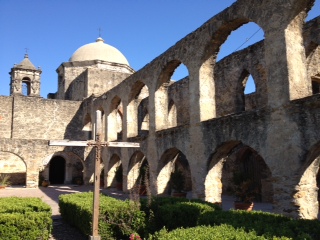
From the outside, the
Guest House at Field Farm in Williamstown is nondescript if not downright ugly. Then you enter the Bauhaus-era home, now a 5-bedroom inn run by the Trustees of Reservations, and you understand the beauty of American modernism. All those rectilinear lines created the perfect opportunity to place large glass windows around the exterior and take in the stunning views of Mount Greylock. Walking into the living room is like walking into a post-modern early 60s museum set where Don Draper is your host. Unlike the architecture, all furniture seems to have curves from the Isamu Noguchi glass coffee table to the swan-backed couch by Vladimir Kagan. For visitors hoping to take in the art at the Clark Art Museum, reopening on July 4th after a major renovation, there’s no better setting.
I started my final day sampling the TTOR properties with breakfast at the Field Farm. Then it was on to another architectural wonder,
Naumkeag in Stockbridge. Formerly owned by the Choate Family of New York before it was bequeathed to The Trustees of Reservations in 1958, Naumkeag is a 44-room Berkshires “Cottage” from the Gilded Age, designed by the prestigious architectural firm of McKim, Mead, and White, and filled with arts, antiques, and collections around from around the world. But it’s the outdoor gardens that truly inspire, a masterpiece of 28 years of collaborative work by former owner, Mabel Choate, and her dear friend, Fletcher Steele, one of America’s first modern landscape architects.
Described by the Library of American Landscape History as a “playground for the imagination,” The Trustees recently completed Phase 1 of an extensive 5-phase, 3-year, $3.3 million garden and landscape restoration project designed to rejuvenate the gardens and bring them back to Choate and Steele’s original vision. I was fortunate to visit Naumkeag prior to Saturday’s opening with Mark Wilson, Curator of Collections. The place hasn’t looked this good since Mabel lived here. The transformation includes the renovation of Fletcher Steele’s iconic Blue Steps, one of the most photographed features in 20th-century American landscape design, lined with budding birches planted last summer. Wilson is almost finished with phase two of the restoration, the Afternoon Garden, where each stone was removed and then meticulously reinserted at the exact same location Steele originally intended. Talk about putting together the pieces of a jigsaw puzzle, this is stone masonry at its finest. Mending the retaining wall and fixing the fountains of the Chinese Garden is still on hold, but Wilson plans to complete the entire project by the summer of 2016. In the meantime, grab food in the café provided by Red Lion Inn and take in the glorious vista of Monument Mountain.
It was August 5, 1850, when 46-year old Nathaniel Hawthorne met fellow author Herman Melville, 32, on a hike up
Monument Mountain. Along with Oliver Wendell Holmes and several others, they brought a wagon loaded with picnic food and champagne to keep the conversation lively. Perched on a ridge, they began to read William Cullen Bryant’s “Monument Mountain,” the story of a young Indian maiden who plunged to her death from the rocky pinnacle when she was forbidden by her Mohican tribe to marry her beloved. When it started to rain, the literary party took to shelter and drink in a recess on the west side of the mountain.
After leaving Naumkeag, I drove 15 minutes south on Route 7 to follow in Hawthorne and Melville’s footsteps and climb the 1,735-foot peak. The hike up, less than 45 minutes, is one of the easiest in the Berkshires—a gradual climb on a well-trodden path through mixed woods of hemlocks, oaks, beech, white pines, red maples, and birches. At a fork, look for a large boulder which commemorates the donation of the park to the Trustees of Reservation in 1899. Here, the trail crawls over rocky ledges to the summit. On this cloudless day, I had vistas of Mt. Everett to the south and the Taconic Range of New York to the west.
Berkshires Regional Director of the Trustees, Joanna Ballantine, who joined me on the hike, shared the news that the Trustees is working out a deal to expand the Monument Mountain property all the way west to the village of Housatonic. This will double the size of the reservation and will include trails that will lead to the summit of Flag Rock. Look for an announcement shortly.
Further south, near the Connecticut border, I made my final stop of the trip at
Bartholomew’s Cobble. Walking on the Ledges Trail, the Housatonic River snakes through dairy farms on the left while eroding limestone and quartzite rocks formed the cobble to our right. I took a slight detour at Corbin’s Neck to get a closer view of the river and the cows resting on its banks. Continuing on the Tulip Tree Trail, I strolled uphill through a forest of tall hemlocks before reaching a clearing. At a short summit, there was a bench to sit on and take in the views of Mount Everett and Mount Race.
Then I veered left on the Hal Borland Trail to visit the Ashley House. Built by Colonel John Ashley in 1735, this is the oldest dwelling in Berkshire County. Colonel Ashley was a pioneer, lawyer, judge and patriot who furnished iron and other supplies for the Revolutionary War effort. He would craft the Massachusetts constitution upstairs with his friend Ethan Allan. On tours on weekend days in the summer, you’ll hear
the story of Mumbet, a slave of the Ashleys who sued her way to freedom. Both the Ashley House and Naumkeag are part of the free
Home Sweet Home Open House Day on Saturday, May 31st.
I want to thank The Trustees of Reservations for setting up my week, especially Kristi Perry for sharing her favorite properties. I want to thank Mother Nature for supplying five perfect days of sunshine. Be on the lookout for my story in the Boston Globe featuring many of the sites I visited this week. As always, thanks for checking in. Enjoy the Memorial Day Weekend!
 If you want to visit New York at a discount, then head to the city during their Eighth Annual Hotel Week in early January. The Refinery Hotel, Library Hotel, High Line Hotel, and Archer New York are just a handful of top-tier properties that will cut their rates considerably during this time. For example, Hotel Edison in Times Square will only be $100 a night, more than 50% off their usual rate. Hotel Week NYC™ was created by PR maven Nancy J. Friedman in 2010 to address the occupancy dip most hotels experience after the holiday season. It’s a perfect time to visit Manhattan without the crowds, see the Andy Warhol exhibition at the Whitney and Network, featuring Bryan Cranston, on Broadway.
If you want to visit New York at a discount, then head to the city during their Eighth Annual Hotel Week in early January. The Refinery Hotel, Library Hotel, High Line Hotel, and Archer New York are just a handful of top-tier properties that will cut their rates considerably during this time. For example, Hotel Edison in Times Square will only be $100 a night, more than 50% off their usual rate. Hotel Week NYC™ was created by PR maven Nancy J. Friedman in 2010 to address the occupancy dip most hotels experience after the holiday season. It’s a perfect time to visit Manhattan without the crowds, see the Andy Warhol exhibition at the Whitney and Network, featuring Bryan Cranston, on Broadway. 
 A 15-minute drive from the base of Monument Mountain and you’ll reach one of the gems on the Trustees roster,
A 15-minute drive from the base of Monument Mountain and you’ll reach one of the gems on the Trustees roster,  If you want to return to Europe, this is the year. Two excellent articles came out last week to help you find the cheapest airfares and the best lodging for your dollar. In Huffington Post, there’s
If you want to return to Europe, this is the year. Two excellent articles came out last week to help you find the cheapest airfares and the best lodging for your dollar. In Huffington Post, there’s  While we dig out of the foot of snow in Boston from yesterday’s nor’easter, my thoughts turn to the warmth of San Antonio, where temperatures reach the low 80s the next 10 days. Lisa and I were actually thinking of renting an apartment in San Antonio this February/March and wished we followed through on our actions. The city offers two world class art museums,
While we dig out of the foot of snow in Boston from yesterday’s nor’easter, my thoughts turn to the warmth of San Antonio, where temperatures reach the low 80s the next 10 days. Lisa and I were actually thinking of renting an apartment in San Antonio this February/March and wished we followed through on our actions. The city offers two world class art museums,  Drive south of Louisville and within 45 minutes, you’ll pass the Jim Beam distillery, a signal that you made it to Kentucky Bourbon Country. More than 1 million visitors stopped at Kentucky bourbon distilleries in 2017, a number that has risen exponentially in the past 2 to 3 years thanks to the surging popularity of bourbon around the world. And perhaps no place is more emblematic of the current love of bourbon than my first stop, the
Drive south of Louisville and within 45 minutes, you’ll pass the Jim Beam distillery, a signal that you made it to Kentucky Bourbon Country. More than 1 million visitors stopped at Kentucky bourbon distilleries in 2017, a number that has risen exponentially in the past 2 to 3 years thanks to the surging popularity of bourbon around the world. And perhaps no place is more emblematic of the current love of bourbon than my first stop, the  From the outside, the
From the outside, the